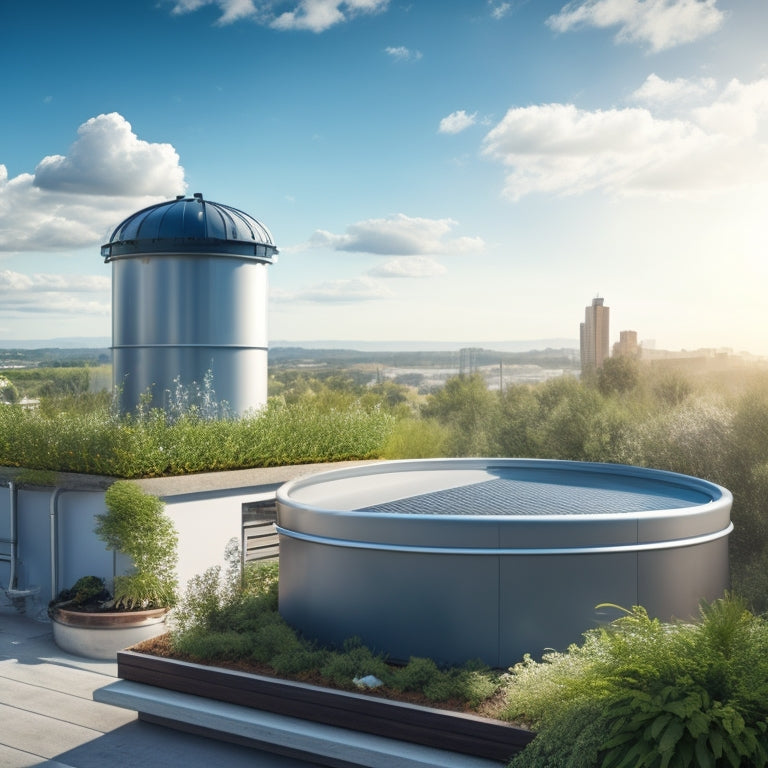
Rooftop Garden Rainwater Harvesting System Costs Revealed
Share
You'll need to invest between $5,000 to $20,000 or more upfront to design and install a rooftop garden rainwater harvesting system that covers materials, labor, and equipment, with the payoff being reduced water bills and increased property value. This cost includes roof catchment installation, gutters and downspout expenses, storage tank purchase, filtration system expenditures, pump and distribution costs, and irrigation system installation. Ongoing maintenance fees and long-term replacement costs will also add to your expenses. As you consider these costs, you'll want to weigh the benefits of a customized system that meets your specific rooftop garden needs.
Key Takeaways
• Initial investment for a rooftop garden rainwater harvesting system ranges from $5,000 to $20,000 or more, covering materials, labor, and equipment.
• Material choice for roof catchment, gutters, and downspouts impacts efficiency, cost, and longevity, with options like EPDM and PVC reducing water loss.
• Storage tank costs vary from $500 to $5,000 or more, depending on material, size, and features, with tank size determining water storage capacity.
• Filtration system expenditures range from a few hundred to several thousand dollars, depending on type and complexity, and pump and distribution costs add another $1,000 to $10,000+.
• Ongoing maintenance fees, including inspections and replacements, and long-term replacement costs for key components every 10-15 years must be factored into the overall cost.
Initial Investment and Setup
You'll need a budget for a significant upfront cost when designing and installing a rooftop garden rainwater harvesting system, which can range from $5,000 to $20,000 or more, depending on the size and complexity of the system. This initial investment covers the cost of materials, labor, and equipment necessary to collect, store, and distribute rainwater for irrigation and other non-potable purposes.
The setup timeline for a rooftop garden rainwater harvesting system can vary, but it typically takes several weeks to a few months to complete, depending on the scope of the project. It's vital to account for the return on investment (ROI) for your system, which can be substantial in the long run. A well-designed system can reduce your water bills, increase your property value, and provide a sustainable source of water for your garden.
When calculating the ROI, don't forget to factor in maintenance expenses, which can include regular inspections, cleaning, and replacement of filters and other components. A system with high efficiency will require less maintenance, resulting in lower costs over time.
Roof Catchment Installation Costs
When installing a roof catchment system, you'll need to factor in the roof material selection, as it impacts the system's overall efficiency and cost.
You'll also need to design a gutter system that can manage the water flow and direct it to the harvesting tank.
Roof Material Selection
Selecting the appropriate roof material is crucial, as it directly impacts the overall efficiency and cost of your rooftop garden rainwater harvesting system. Factors like durability, water absorption, and rooftop accessibility influence your roof catchment installation costs. You'll want to choose a material that's resistant to corrosion, can withstand weathering, and allows for efficient water flow.
When contemplating roof materials, reflect on how they'll interact with your plant selection. For example, some plants may require more frequent watering, which could affect your water storage needs. You'll also want to ponder drainage solutions to guarantee excess water is properly redirected.
A well-chosen roof material selection will help minimize water loss and reduce your system's overall costs. Look for materials with low water absorption rates, such as EPDM or PVC, to minimize water loss and optimize your system's performance.
Gutter System Design
Designing a gutter system that effectively captures and channels rainwater into your rooftop garden rainwater harvesting system is crucial, as it directly impacts the system's overall efficiency and cost. Factors like gutter material, size, and slope influence roof catchment installation costs.
As you plan your gutter system, consider the following key factors to optimize rainwater collection for your garden design:
-
Gutter material: Aluminum, steel, or vinyl gutters each have their own strengths and weaknesses, impacting durability, maintenance, and cost.
-
Gutter size: Larger gutters can handle heavier rainfall, but may be more costly and visually obtrusive.
-
Gutter slope: A properly angled gutter system ensures water flows efficiently towards the downspout, reducing clogs and overflow.
- Downspout placement: Strategically situating downspouts to direct water into your rainwater harvesting system, rather than allowing it to flow onto the ground or nearby surfaces.
Gutters and Downspout Expenses
When calculating the costs of your rooftop garden rainwater harvesting system, you'll need to take into account the expenses associated with gutters and downspouts. Specifically, you'll want to ponder the material options for your downspouts, as well as the costs of regular gutter cleaning to guarantee your system runs efficiently.
Downspout Material Options
You'll need to choose a durable and corrosion-resistant downspout material that can withstand outdoor exposure and handle the weight of rainwater, which is where options like aluminum, vinyl, and steel come into play. Each material has its pros and cons, and selecting the right one can greatly impact your rainwater harvesting system's performance and longevity.
When it comes to downspout material options, consider the following factors:
-
Cost: Aluminum and vinyl downspouts are generally more affordable than steel, but may not be as durable.
-
Durability: Steel downspouts are more resistant to corrosion and can withstand heavy rainwater flow, but may require more maintenance.
-
Installation: Vinyl downspouts are often easier to install, but may not be as flexible as aluminum or steel.
- Rainwater filtration: Some downspout materials, like steel, can be more compatible with rainwater filtration systems, ensuring cleaner water for your rooftop garden.
Gutter Cleaning Costs
As you finalize your downspout material selection, it's equally significant to factor in the ongoing expenses associated with maintaining your gutter system, including regular cleaning costs that can impact your rooftop garden rainwater harvesting system's overall performance.
Failure to clean your gutters can lead to debris accumulation, causing water to overflow and potentially damage your rooftop garden or walls. This can result in costly gutter repair or even require a complete gutter installation.
You can expect to pay between $100 to $300 per year for professional gutter cleaning services, depending on the size of your rooftop and the frequency of cleaning. If you prefer to clean your gutters yourself, you'll need to invest in the necessary equipment, such as a ladder, gloves, and a scoop, which can cost around $100 to $200.
Regular gutter cleaning is essential to make certain your rooftop garden rainwater harvesting system functions efficiently. By factoring in these costs, you can budget accordingly and avoid unexpected expenses down the line.
Storage Tank Purchase Price
Purchasing a storage tank is a significant expense in a rooftop garden rainwater harvesting system, with prices ranging from $500 to $5,000 or more, depending on the tank's material, size, and features. As you explore your options, you'll want to contemplate the tank size you need, which will impact the overall cost. A larger tank will generally cost more, but it will also provide you with a greater water storage capacity.
Here are some factors to ponder when selecting a storage tank:
-
Material: Tanks can be made from plastic, metal, or concrete, each with its own set of benefits and drawbacks. Plastic tanks are often the most affordable, while concrete tanks are generally the most durable.
-
Capacity: How much water do you want to store? Tanks come in a range of sizes, from 500 gallons to 10,000 gallons or more.
-
Features: Do you want a tank with built-in filtration or mosquito-proof screens? These features will add to the overall cost.
- Installation process: Will you be installing the tank yourself, or hiring a professional? The installation process will also impact the overall cost of the tank.
Filtration System Expenditures
Your storage tank is filled with harvested rainwater, but now it's time to think about the filtration system that will make this water safe and suitable for your rooftop garden, with expenditures ranging from a few hundred to several thousand dollars. This system is vital, as it'll remove contaminants, sediment, and bacteria, making the water suitable for irrigation and other non-potable uses.
You'll need to think about the type of filtration system, such as sedimentation, filtration, or disinfection, depending on your water usage and rooftop garden requirements.
The cost of the filtration system will depend on the complexity, size, and type of system you choose. A basic sedimentation system can start at around $500, while a more advanced filtration system with UV treatment can cost upwards of $5,000.
It's crucial to think about the environmental impact of your filtration system, as it'll affect the quality of water used in your rooftop garden. By investing in an efficient filtration system, you'll reduce your reliance on municipal water supplies, minimizing your water usage and environmental footprint.
Pump and Distribution Costs
You'll need a reliable pump and distribution system to transport the filtered rainwater from your storage tank to your rooftop garden, which can cost anywhere from $1,000 to $10,000 or more, depending on the size and complexity of the system. This system is essential for efficient water distribution to your rooftop garden.
When selecting a pump and distribution system, consider the following factors to guarantee energy efficiency and system optimization:
-
Pump type and size: Choose a pump that matches your water distribution needs, taking into account flow rate, pressure, and power consumption.
-
Pipe material and sizing: Select pipes that are resistant to corrosion and can withstand the water pressure, ensuring minimal maintenance costs.
-
Valves and fittings: Install valves and fittings that allow for easy system maintenance and minimize water loss.
- Automation and control systems: Consider investing in automation systems that optimize water distribution, reducing energy consumption and maintenance costs.
Irrigation System Installation
With the pump and distribution system in place, the next step is to design and install an efficient irrigation system that effectively delivers rainwater to your rooftop garden's plants, taking into consideration factors like soil type, plant density, and climate conditions.
You'll need to contemplate design elements such as drip irrigation, micro-sprinklers, or soaker hoses to make sure water is delivered directly to the roots, minimizing evaporation and runoff. This thoughtful approach won't only conserve water but also reduce your environmental impact.
By harnessing rainwater, you'll decrease your reliance on municipal water supplies, reducing the energy required to treat and transport water. This sustainable practice also helps to mitigate urban runoff, which can pollute local waterways.
A well-designed irrigation system will also promote healthy plant growth, reduce soil erosion, and create a thriving ecosystem. By investing in an efficient irrigation system, you'll reap the benefits of water conservation while contributing to a more sustainable future.
Ongoing Maintenance Fees
How much will it cost to keep your rooftop garden rainwater harvesting system running smoothly over time? As you enjoy the sustainability benefits of harvesting rainwater, you'll need to take into account the ongoing maintenance fees to maintain your system's efficiency and effectiveness.
Regular maintenance is vital to preserving good water quality and preventing contamination. Here are some costs you can expect to incur:
-
Inspections and testing: Regular checks to confirm the system is functioning correctly and water quality is within acceptable limits. ($100-$300 per year)
-
Filter replacements: Replacing filters to sustain water quality and prevent clogging. ($50-$100 per year)
-
Pump maintenance: Regular servicing of pumps to guarantee they remain efficient and effective. ($100-$200 per year)
- Gutter cleaning: Cleaning gutters and downspouts to ensure proper water flow. ($100-$200 per year)
Long-Term Replacement Costs
Every 10 to 15 years, you can expect to replace key system components, such as tanks, pumps, and filters, to maintain your rooftop garden rainwater harvesting system's performance and water quality. This is an essential aspect of replacement budgeting and future planning, ensuring your system continues to meet your water needs and sustainability goals.
To give you a better idea of the costs involved, here's a breakdown of the estimated replacement costs for different system components:
| Component | Replacement Frequency | Estimated Cost |
|---|---|---|
| Tanks | 10-15 years | $5,000 - $10,000 |
| Pumps | 10-15 years | $1,000 - $3,000 |
| Filters | 5-10 years | $500 - $2,000 |
| Other components (valves, pipes, etc.) | 5-10 years | $1,000 - $5,000 |
Frequently Asked Questions
Can I Install a Rooftop Garden Rainwater Harvesting System Myself?
"You're a DIY mastermind, but even you might struggle with a rooftop garden rainwater harvesting system installation - it's a complex beast! However, with the right maintenance tips, you can conquer this project and enjoy the fruits of your labour."
Are There Any Local Incentives for Rainwater Harvesting Systems?
You'll be pleased to know that many local governments offer incentives for rainwater harvesting systems, including cost savings through rebates and tax credits, making your eco-friendly investment even more attractive.
How Often Should I Inspect My Rooftop Garden Rainwater System?
'Like a vigilant captain monitoring their vessel, you should inspect your rooftop garden rainwater system quarterly to guarantee peak efficiency, troubleshoot potential issues, and perform necessary maintenance to keep it running smoothly and freely.'
Can I Use Harvested Rainwater for My Household Appliances?
You can use harvested rainwater for household appliances, but guarantee the water quality meets safety standards for your intended water usage, and consider the appliances' compatibility with non-potable water to avoid damage.
Are Rooftop Garden Rainwater Harvesting Systems Environmentally Friendly?
As you set out on a quest for eco-friendliness, you'll discover rooftop garden rainwater harvesting systems are a beacon of sustainability, conserving water and promoting urban agriculture while minimizing environmental impact, ultimately liberating you from dependence on municipal supplies.
Related Posts
-

Why Succulents Thrive in DIY Concrete Planters
You've likely noticed that succulents seem to flourish in DIY concrete planters, and it's not just a coincidence - th...
-

Why Succulents Thrive in DIY Concrete Planters
You've likely noticed that succulents seem to flourish in DIY concrete planters, and it's not just a coincidence - th...
-

Why Succulents Thrive in DIY Concrete Planters
You've likely noticed that succulents seem to flourish in DIY concrete planters, and it's not just a coincidence - th...
-

Why Succulents Thrive in DIY Concrete Planters
You've likely noticed that succulents seem to flourish in DIY concrete planters, and it's not just a coincidence - th...
-

Why Succulents Thrive in DIY Concrete Planters
You've likely noticed that succulents seem to flourish in DIY concrete planters, and it's not just a coincidence - th...
-

Why Succulents Thrive in DIY Concrete Planters
You've likely noticed that succulents seem to flourish in DIY concrete planters, and it's not just a coincidence - th...
-

Why Succulents Thrive in DIY Concrete Planters
You've likely noticed that succulents seem to flourish in DIY concrete planters, and it's not just a coincidence - th...
-

Why Succulents Thrive in DIY Concrete Planters
You've likely noticed that succulents seem to flourish in DIY concrete planters, and it's not just a coincidence - th...
-

Why Succulents Thrive in DIY Concrete Planters
You've likely noticed that succulents seem to flourish in DIY concrete planters, and it's not just a coincidence - th...
-

Why Succulents Thrive in DIY Concrete Planters
You've likely noticed that succulents seem to flourish in DIY concrete planters, and it's not just a coincidence - th...
-

Why Succulents Thrive in DIY Concrete Planters
You've likely noticed that succulents seem to flourish in DIY concrete planters, and it's not just a coincidence - th...
-

Why Succulents Thrive in DIY Concrete Planters
You've likely noticed that succulents seem to flourish in DIY concrete planters, and it's not just a coincidence - th...
-

Why Succulents Thrive in DIY Concrete Planters
You've likely noticed that succulents seem to flourish in DIY concrete planters, and it's not just a coincidence - th...
-

Why Succulents Thrive in DIY Concrete Planters
You've likely noticed that succulents seem to flourish in DIY concrete planters, and it's not just a coincidence - th...
-

Why Succulents Thrive in DIY Concrete Planters
You've likely noticed that succulents seem to flourish in DIY concrete planters, and it's not just a coincidence - th...
-

Why Succulents Thrive in DIY Concrete Planters
You've likely noticed that succulents seem to flourish in DIY concrete planters, and it's not just a coincidence - th...
-

Why Succulents Thrive in DIY Concrete Planters
You've likely noticed that succulents seem to flourish in DIY concrete planters, and it's not just a coincidence - th...
-

3 Best DIY Planter Ideas for Backyard Decor
You can elevate your backyard's style and functionality by choosing the right DIY planter ideas. Start with a mix of ...
-

3 Best DIY Planter Ideas for Backyard Decor
You can elevate your backyard's style and functionality by choosing the right DIY planter ideas. Start with a mix of ...
-

3 Best DIY Planter Ideas for Backyard Decor
You can elevate your backyard's style and functionality by choosing the right DIY planter ideas. Start with a mix of ...
-

3 Best DIY Planter Ideas for Backyard Decor
You can elevate your backyard's style and functionality by choosing the right DIY planter ideas. Start with a mix of ...
-

3 Best DIY Planter Ideas for Backyard Decor
You can elevate your backyard's style and functionality by choosing the right DIY planter ideas. Start with a mix of ...
-

3 Best DIY Planter Ideas for Backyard Decor
You can elevate your backyard's style and functionality by choosing the right DIY planter ideas. Start with a mix of ...
-

3 Best DIY Planter Ideas for Backyard Decor
You can elevate your backyard's style and functionality by choosing the right DIY planter ideas. Start with a mix of ...
-

3 Best DIY Planter Ideas for Backyard Decor
You can elevate your backyard's style and functionality by choosing the right DIY planter ideas. Start with a mix of ...
-

3 Best DIY Planter Ideas for Backyard Decor
You can elevate your backyard's style and functionality by choosing the right DIY planter ideas. Start with a mix of ...
-

3 Best DIY Planter Ideas for Backyard Decor
You can elevate your backyard's style and functionality by choosing the right DIY planter ideas. Start with a mix of ...
-

3 Best DIY Planter Ideas for Backyard Decor
You can elevate your backyard's style and functionality by choosing the right DIY planter ideas. Start with a mix of ...
-

3 Best DIY Planter Ideas for Backyard Decor
You can elevate your backyard's style and functionality by choosing the right DIY planter ideas. Start with a mix of ...
-

3 Best DIY Planter Ideas for Backyard Decor
You can elevate your backyard's style and functionality by choosing the right DIY planter ideas. Start with a mix of ...
-

3 Best DIY Planter Ideas for Backyard Decor
You can elevate your backyard's style and functionality by choosing the right DIY planter ideas. Start with a mix of ...
-

5 Tips for Thriving Vertical Vegetable Gardens
To thrive in vertical vegetable gardening, you'll want to choose a planter that meets the unique needs of your veggie...
-

5 Tips for Thriving Vertical Vegetable Gardens
To thrive in vertical vegetable gardening, you'll want to choose a planter that meets the unique needs of your veggie...
-

5 Tips for Thriving Vertical Vegetable Gardens
To thrive in vertical vegetable gardening, you'll want to choose a planter that meets the unique needs of your veggie...
-

5 Tips for Thriving Vertical Vegetable Gardens
To thrive in vertical vegetable gardening, you'll want to choose a planter that meets the unique needs of your veggie...
-

5 Tips for Thriving Vertical Vegetable Gardens
To thrive in vertical vegetable gardening, you'll want to choose a planter that meets the unique needs of your veggie...
-

5 Tips for Thriving Vertical Vegetable Gardens
To thrive in vertical vegetable gardening, you'll want to choose a planter that meets the unique needs of your veggie...
-

5 Tips for Thriving Vertical Vegetable Gardens
To thrive in vertical vegetable gardening, you'll want to choose a planter that meets the unique needs of your veggie...
-

5 Tips for Thriving Vertical Vegetable Gardens
To thrive in vertical vegetable gardening, you'll want to choose a planter that meets the unique needs of your veggie...
-

5 Tips for Thriving Vertical Vegetable Gardens
To thrive in vertical vegetable gardening, you'll want to choose a planter that meets the unique needs of your veggie...
-

5 Tips for Thriving Vertical Vegetable Gardens
To thrive in vertical vegetable gardening, you'll want to choose a planter that meets the unique needs of your veggie...
-

5 Tips for Thriving Vertical Vegetable Gardens
To thrive in vertical vegetable gardening, you'll want to choose a planter that meets the unique needs of your veggie...
-

5 Tips for Thriving Vertical Vegetable Gardens
To thrive in vertical vegetable gardening, you'll want to choose a planter that meets the unique needs of your veggie...
-

5 Tips for Thriving Vertical Vegetable Gardens
To thrive in vertical vegetable gardening, you'll want to choose a planter that meets the unique needs of your veggie...
-

5 Tips for Thriving Vertical Vegetable Gardens
To thrive in vertical vegetable gardening, you'll want to choose a planter that meets the unique needs of your veggie...
-

5 Tips for Thriving Vertical Vegetable Gardens
To thrive in vertical vegetable gardening, you'll want to choose a planter that meets the unique needs of your veggie...
-

5 Tips for Thriving Vertical Vegetable Gardens
To thrive in vertical vegetable gardening, you'll want to choose a planter that meets the unique needs of your veggie...
-

5 Tips for Thriving Vertical Vegetable Gardens
To thrive in vertical vegetable gardening, you'll want to choose a planter that meets the unique needs of your veggie...


